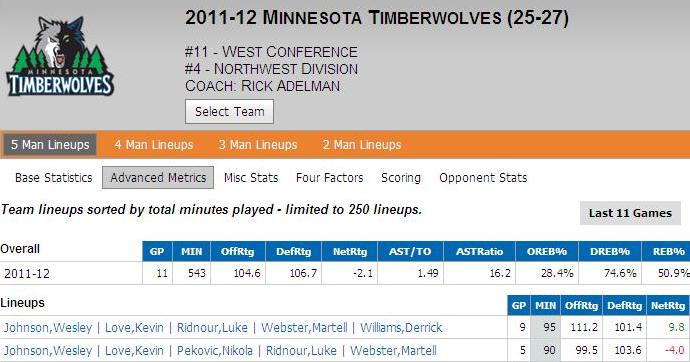Ariza Injury Update »
Tracking the T’Wolves – 5-Man Rotations, and the Hornets’ Newest Enemy

In this week’s edition of Hornets247’s weekly Tracking the T’Wolves series, Mason takes a look at some of Minnesota’s more frequently used active lineups before and after Rubio’s injury, and then presents the T’Wolves player that is effectively helping to keep his team’s playoff chances afloat as of late.
Every week, this column typically either pokes fun at the Timberwolves, calls them out for being too close to above-average, or both. This week, I will do neither; in fact, I will go out of my way to thank Minnesota’s NBA franchise for helping our Hornets out.
Thanks to NBA.com’s new stats tool which Joe explored recently, we can take a look at some in-depth numbers surrounding every different 5-man lineup that the T’Wolves have used this season. In particular, I focused on the team’s most heavily utilized lineups, and the net ratings for those lineups (the difference between points scored per 100 possessions and points allowed per 100 possessions). The findings?
To this point in the 2011-12 season, the Minnesota Timberwolves’ most common active (Rubio-less) lineup – consisting of Luke Ridnour, Wesley Johnson, Michael Beasley, Kevin Love, and Darko Milicic – has a net rating of -8.6.
So, to be blunt, the 5-man rotation that the Timberwolves have used most frequently this season that does not include injured PG Ricky Rubio is actually performing well below average.
I thought that info was dynamite, and was truly excited to see it… until I did some more digging and realized that Coach Rick Adelman hasn’t used that lineup since January. Turns out those darned Timberwolves are smarter than we thought, and actually learn from their mistakes! However, with this stats tool, we can look at specific time ranges in order to obtain more pertinent data.
The most obvious filter was to only include the games that have been played since Rubio went down on March 9th. Looking at just those 11 games, Minnesota’s most frequently used lineup with 95 minutes played sits at a +9.8 net rating; however, the one right behind it, which has seen 90 minutes of action, is a promising -4.0. As you can see from the above image, the only difference between the two lineups is the insertion of one player – Derrick Williams for Nikola Pekovic. In fact, out of the T’Wolves’ six most frequently used lineups, four have positive net ratings and two have negative net ratings. Williams is in three of the four groups with positive ratings, and zero of the two that are negative.
The sample size drops off substantially after the first two aforementioned rotations, but it is still worth noting how much Derrick Williams seems to improve Minnesota’s performance as a team, especially considering the fact that Pekovic has put up very solid individual numbers for the T’Wolves this season. I would argue that an equally important residual effect of the Williams for Pekovic substitution is the fact that by making this change, Love moves from PF to C, which helps both on both sides of the ball.
Offensively, Derrick Williams has a much more extended range than Pekovic, attempting 6.1 shots from 16 feet and beyond per 40 minutes (the league average for forwards is just 2.9); this forces defenders to extend outside of the paint to defend him, allowing Love much more room to operate inside (when he isn’t draining 3-pointers, of course). Not coincidentally, in the 11 games since Rubio’s injury, the offensive rating for the Williams lineup is nearly 12 points higher than the rotation that includes Pekovic instead.
Defensively, there has been less of a statistical impact (just a 2 point improvement in defensive rating), but the change is still relevant. One of Love’s few short-comings is his defensive mobility; he is at his best on D when he can use his body down low and try to out-muscle his matchups without having to extend far from the basket. With Williams able to better defend some of those stretch 4s, Love can focus on defending near the hoop, keeping his defensive flaws from being easily exposed.
So, what’s the takeaway here? Basically, that the Derrick Williams/Kevin Love frontcourt combination is a really effective one. While a game against a team with a center such as Howard or Bynum could give that tandem some problems defensively, the two produce very well together overall. Despite the fact that Pekovic brings more to the table individually than Williams at this point in each of their careers, the Timberwolves simply play better when Williams and Love are on the court together as the team’s big men.
Check out the Tracking the T’Wolves weekly series here, and follow Mason on twitter at @WhoDatHornet88.
Statistical support for this story acquired from NBA.com.





